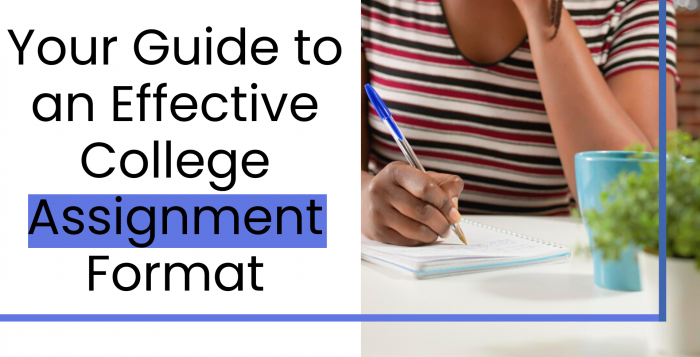Your Guide to an Effective College Assignment Format
If writing a decent college essay has been the bane of your existence as a student, then you’ve stumbled upon the right place. There are a lot of variables to consider when writing a college assignment, especially one that warrants decent validation and a good grade. Formatting your essay actually implies to structure your essay according to the college paper header and what it prompts. The first step is to decide what you will want to write about in your outline, planning out your thesis, and then structuring and “formatting” it to make it into order. This guide is here to effectively help you develop your college assignment writing format.
Well essentially, there are a few major aspects to take care of, when writing or constructing your college assignment format. If you carefully oblige to the guidelines given below, you’re sure to ace that college paper and might just enjoy the process while you’re at it, tackling the obstacles that may arise.
STAGE 1: PLANNING
Planning and drafting your essay outline is an essential step in your process of constructing an articulate college assignment format. What outlining a draft will do is basically consolidate all your ideas into a well-structured argument. Furthermore, while writing your college assignment, you must be vary of the technicalities that could smartly get you to secure marks. Make sure to check how much weightage is being accounted for this assignment in the final grade and then see how much time is it worth being spent on. Factor in things such as researching, drafting, and writing, and then formatting.
Moreover, check the marking criteria and schemes to have an idea of what you can score on and what you can lose them on too. What this will ensure is that you stay on topic and relevant throughout the entirety of your paper. Another important tip to consider when we talk about being relevant is to keep going back to reference the college assignment heading – the question and what it demands in your college paper, based off of your college essay heading.
STAGE 2: DRAWING OUTLINE & COLLEGE ESSAY HEADINGS
As you start to construct an outline of your college essay, you are instantly given the chance to galvanize your paper entirely. The outline that you are preparing will aid you in streamlining your argument, making it easier for you to decide what to add and what to omit. Using that outline, you may then write out your college paper assignment heading, which will serve the purpose of actually cataloging your main argument, your thesis.
Typically the college essay format you follow has a 3-part structure:
1. Introduction:
This part of the essay is the one where you aim to introduce the topic and set the tone of the essay, generally and discuss what your thesis statement will be and what are the main ideas that will support it. When penning down the introduction, you may also demonstrate what will be the probable findings and results of the college essay and how it is related to the college assignment header, and what it aims to explore. Typically, the introduction should not take more than 10-15% of your entire college essay. Do not attempt to over-explain in your college essay, what you will aim to explain in the following paragraphs.
2. The Body:
This section of the paper is supposed to detail what your essay contains and the major portion of your argument. The presented thesis, the topic sentence, the analysis of the thesis, and then the cross-analysis which only show how secure your thesis is, if written correctly. This is also followed up by results and the findings that you’ve consolidated and now are presenting in your paper. In the body paragraph, what you can do is to systemically break down the core argument of your college essay by addressing each individual area (that was aforementioned) into their own separate paragraphs.
To inaugurate a new point, your topic sentence should be able to address each point, the idea, and the evidence that is supposed to back it up, along with the necessary references and examples. When primarily drafting the essay you can assemble rough topic sentences that you would like to begin with and then start off with the paragraphs that would address the main points. Because the section contains the bulk of your essay and its contents, this should account for around 80% of the essay.
3. Conclusion:
This section of the paper aims to sum up what the thesis of your argument was, by reiterating it (not repeating it – this is to be taken specific care of. Please do not repeat the thesis itself, but make sure to remind the reader by mentioning it clearly again.) In essence, the purpose of a conclusion is to summarize the entirety of your college essay in a generalized manner which addresses the main points and then also evaluates them. Typically it is preferred to not introduce any new information as this may subjugate some of the main premise of the argument towards the end, which will be counter-intuitive, and thus it is better not to do it. This section of the paper also happens to take up around 10-15 of the paper’s portion.
STAGE 3: WRITING THE ESSAY
After you’re done with all the preliminary research work and complaining and organizing your drafts to the essay – it is time to get to focus on the college assignment heading format. This is basically just your college assignment heading which is supposed to entail the subject matter and the context that is going to present in the essay. While it is often an overlooked element of the college essay, the writer must understand its significance. It is supposed to hook the reader to the paper, and the more engaging the argument presented in the paper is (backed up by concrete evidence, analysis, and references), the better marks you are to secure. It is also imperative to address the question itself and should be to-the-point and strong. Avoid ambiguity in the college essay heading and try to not overdo it. It is just a one-liner after all.
Prepare yourself for the writing grind. When writing some of your very first drafts it is your default position to make mistakes. Therefore, rewriting, proofreading and editing will have to become second nature to you, to secure the highest marks possible.
Guidelines for the Standard Formatting in your College Essay
• File Format
MS Word is the most commonly used format. But if that’s not available then you may also access online resources like Google Docs or the Outlook MS version which give you access to the Online MS Word version itself. Assignments are to be submitted in one of the following file formats which include .rtf., .xlsx, .xls, or most commonly .docx, or .doc. Avoid submitting web pages, HTML files, Visio (.vsd), CAD files, PDFs (.pdf), PowerPoint (.ppt), or ZIP files unless the subject teacher mentions otherwise.
• Fonts
When writing your essay, do not underestimate the importance of this. The font has a purpose and each font has a different aim. However, when writing college essays make sure to look up college assignment format guides and double-check for the correct ones. The standard is usually Times New Roman, Calibri, Verdana, Arial or Tahoma, including a few others. Please also take care that you use the same font consistently throughout the paper. Negative marking otherwise is possible as it makes the essay lose its credibility. Keep the font size from 10-12. Also, avoid using colored backgrounds for your paper (unless you’ve been given special permission in the case that you may have a particular medical condition.)
• Spacing
Use at least 1 and a half or 1.5 spacing or double, 2.0 spacing with equally wide margins. This lets the marker to make comments. Also, ensure leaving blank lines between paragraphs. If the questions are short and to the point, leave a blank line between each question too. If they are long, start each question on a new page.
• Headings
The college essay heading format goes this way – it should be in bold. It should not be underlined or be in italics. If a sub-heading is required, write one.
• Title Page
This should include – the title and assignment number, the course number, name, and due date, along with the student name and number. This should ideally be centered down, on that one-third of the page.
• Numbering
Add page numbers to all the pages except the title page. The figures and tables that are used in the paper must be clearly numbered and referenced. Captions for tables are usually formatted above the table, while figure captions go below the figure. Do not number the items in a reference list.
• Headers and Footers
These include information like your name (first and last), your student number, course number, assignment number, and page number – in format order.
• Word Count
Include a word count (the number of words in your assignment) at the end of the assignment, before the references and appendices. Your assignment should exceed more than 10% under or over the determined word count. Keep in mind that that the title/title page, reference list, and appendices – are not to be included in the word count addition. Some assignments have word limits – please read the Assessment Word Limit Policy to understand the potential penalties for exceeding the word limit.
Final Word
The tips and guidelines in this college assignment writing service will make sure your college paper will be one that garners you a good enough grade to meet your academic aspirations. Good luck!



